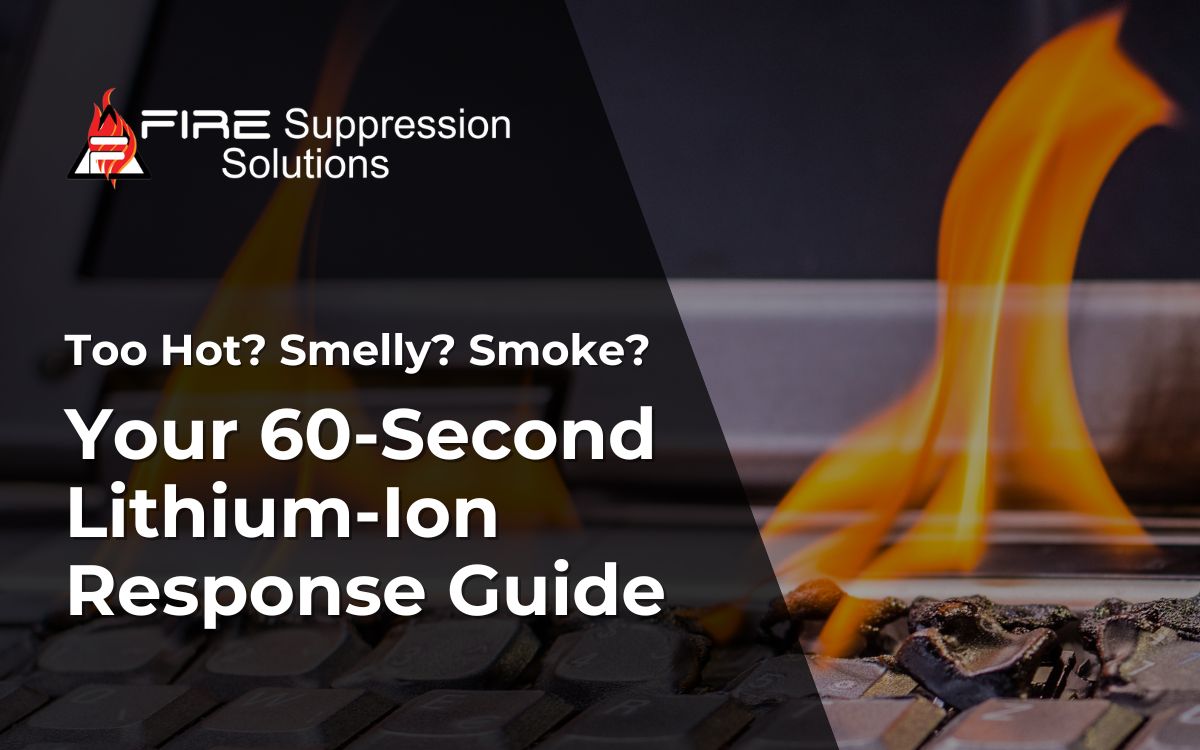Lithium-ion battery fires are not ordinary fires. They’re driven by a self-sustaining chemical chain reaction (thermal runaway) that burns hotter and can re-ignite after flames appear to die down. The goal isn’t to “smother and move on”—it’s to keep hands off, isolate the room, and cool the cells if (and only if) you have the right tool and it’s safe to do so.
Know the early warning signs
- Heat that keeps building
- burning odor
- Swelling or bulging case
- Hissing/crackling or venting
- Smoke or flame
If you see any of the above, move fast—without touching the device.
The 60-second response (timeline)
0–10 seconds: Hands off.
Do not pick up, carry, or throw the device outside. This could result in serious burns.
10–20 seconds: Isolate people, isolate the room.
Guide everyone away. If you can do it safely, close the door to the space where the device is. Closed-door isolation limits heat spread and gases.
20–30 seconds: Call 911.
Give a plain description (“laptop battery smoking in an office,” “e-scooter pack venting in a garage”) and confirm your location. Stay available by phone.
30–45 seconds: If small—and only if equipped—extinguish the pack.
From a safe distance, use a certified lithium-Ion extinguisher (TRF+ StaySafe extinguisher) engineered for lithium-ion. If you are not equipped or it’s not safe, stop here and wait outside the closed door.
45–60 seconds: Control the area.
Keep the door closed. Account for people. Meet responders and point out the room and power source (e.g., charger outlet). If a cord or charger is the source and you can reach the plug without crossing smoke or flame, unplugging it may help—only if it’s safe.
Plain and simple: Traditional (ABC) dry-chemical extinguishers do not work on lithium-ion battery fires. They can knock down visible flames for a moment but do not stop thermal runaway, so heat rebuilds and the pack can re-ignite.
Don’t do this
- Don’t smother with blankets, pillows, or clothing (traps heat and poisonous gases).
- Don’t aim a fan at it (pushes poisonous gases).
- Don’t move a smoking device through hallways or downstairs.
- Don’t rely on ABC dry-chem because they will not work.
Situational notes
Home/Garage
Leave the device where it is, close the door, get people out, call 911. Keep exits clear ahead of time so evacuation is easy.
Classroom/Library
Use your radio/office line as you close the door and move students away. Charging should happen on tables/stations—not in aisles—so isolation is simple when seconds matter.
Workplace/Warehouse
Follow your posted incident sheet (Isolate • Evacuate • 911). Keep charging out of egress paths so you can shut the door and clear the area quickly. Replace any power strips that feel warm or loose—they’re a setup problem waiting to happen.
Apartments/Renters
No hallway charging. If a device vents inside a unit: hands off, close the unit door, alert neighbors on the way out, call 911.
After the incident
- Assume re-ignition risk until responders say otherwise.
- Do not reuse the device or pack.
- Ventilate only when safe and approved by responders.
- Arrange proper disposal for damaged batteries/electronics (batteries never go into trash or recycling).
Prevention that actually helps
Most events never happen when you build the right habits:
Buy smart — Choose listed products and power strips; use OEM/approved chargers; retire swollen, crushed, or water-damaged packs.
Charge smart — Hard, flat, uncovered surfaces; no daisy-chains; one UL power strip per outlet; keep exits clear; unplug when full.
Recycle right — Tape terminals on loose cells, bag them, and take them to a drop-off—never throw in the trash.
Keep everyone on the same page
We’ve turned these steps into simple, ready-to-use materials for homes, classrooms, and workplaces. Visit our Fire Prevention Week Resource Hub (free downloads) for response steps, charging rules, renter tips, and more—so your whole community hears the same message: buy smart, charge smart, recycle right.
Safety note: Always follow manufacturer instructions, local policy, and on-scene directions from first responders.
Reviewed by the Fire Suppression Solutions Technical Team.

